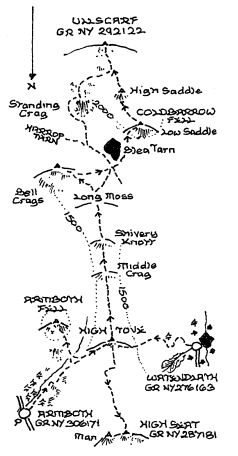|
ROUTE ONE. (A) ULLSCARF FROM WATENDLATH VIA HIGH
TOVE, NAMELESS TOP (Bell Crags), AND COLDBARROW FELL (Low Saddle) OR FROM
ARMBOTH PLUS ARMBOTH FELL.
4.75 miles 1950ft of ascent from Watendlath or 6 miles 2300ft
of ascent from Armboth.
(B) HIGH SEAT FROM WATENDLATH VIA HIGH TOVE OR FROM ARMBOTH PLUS
ARMBOTH FELL.
2 miles 1200ft of ascent from Watendlath. 3.25 miles 1550ft of ascent
from Armboth.
|
Ascent Breakdown
|
Distance
|
Ascent
|
|
miles
|
km
|
ft
|
metres
|
|
Armboth to Armboth Fell.
|
1.25
|
2
|
950
|
290
|
|
Armboth Fell to High Tove.
|
1
|
1.6
|
250
|
76
|
|
Watendlath to High Tove.
|
1
|
1.6
|
850
|
259
|
|
High Tove to Nameless Top.
|
1.75
|
2.8
|
300
|
91
|
|
Nameless Top to Coldbarrow Fell.
|
1.25
|
2
|
500
|
152
|
|
Coldbarrow Fell to Ullscarf.
|
0.75
|
1.2
|
300
|
91
|
|
High Tove to High Seat.
|
1
|
1.6
|
350
|
107
|
|
|
click to enlarge
|
This route should preferably
be done only after a long dry spell or when the ground is frozen. In such
conditions the moorland of the ridge between Thirlmere and Watendlath can provide a
good day out, but if wet then just about anywhere else will be better! If starting at Armboth go
up the signposted public path to Watendlath, and stay with it beyond the enclosure
wall until the slope eases and a fairly level crossing on the left can be made to
Armboth Fell. If the bend in the stream is aimed for a path through the heather to the
summit may be found. It is clearly in view when standing on the top; which when the
heather is in bloom is the perfect place to be. Descend the path back to the
stream and it's continuation on the far bank. At present it does not
run through to the
main track up to High Tove, but is some help if rather wet. The
main track climbs
gradually to the big cairn on the top. From Watendlath the path
to High Tove can
clearly be seen winding up to the top of the enclosures. It has been
well reconstructed,
and it is a pity the work did not carry on ahead at the wall corner all the way to High
Tove. Instead make the best of the soggy ground, and welcome the dry summit
area on arriva1. The fence links High Tove and Ullscarf, but areas of peat hags poo1s
and waterlogged grass will require detours. The right hand side of the fence is the
best initially. The ground eventually rises beyond Shivery Knott, and then crosses
Long Moss with more promising ground ahead. The fence goes part way up the
slope, but when it turns sharply right continue up to the pleasant top adorned by an
Ordnance Survey column. The summit is strictly nameless which seems a
pity when less worthy places here have one! The imposing front of Standing Crag
rises ahead along the ridge, and this presents the simplest route to Ullscarf from
here. The path swings round the crag on the left, and climbs steadily to the extensive
summit plateau. The preferred route goes down to the outlet of the tarn where swing
south and ascend the ridge to Coldbarrow Fell (Low Saddle) a fine top with a
wonderful view of the Watendlath valley. A good path heads up to
High Saddle and the
summit plateau of Ullscarf.
If High Seat is the objective the conditions underfoot from
High Tove are no better at first. Follow the fence north and round the angle at Eddy
Grave Stake avoiding as much water and bog as possible. The last section before the
ascent to High Seat begins is especially bad to negotiate, but the summit is a
pleasant place. From Ullscarf Watendlath is most easily reached along the
bridleway by Blea Tarn, but a more interesting route is by Low Saddle then going down
the moor east of Dock Tarn. The ground is not easy as the tarn is neared with
the best walking being alongside the wall by High Crag to join the path from
Stonethwaite. Turn right up to Dock Tarn after which the
path starts it's decent to Watendlath. For Armboth the east ridge can be descended
to the fine vantage point above Nab Crags reaching the road north of West Head.
To retum to Armboth from High Seat a visit to Raven Crag
is recommended. Descend
the moor below Man, and aim for the gate in the deer fence due east. Turn
left along the forest
road to the signposted junction. After returning from Raven Crag
go down the path to
the Thirlmere dam and walk by the lake back to Armboth. To avoid another crossing of
High Tove a descent by the path down Ashness Gill might be tried for a return to
Watendlath. From the bridge walk by Surprise View, and finish by the track alongside
Watendlath Beck.
|
|